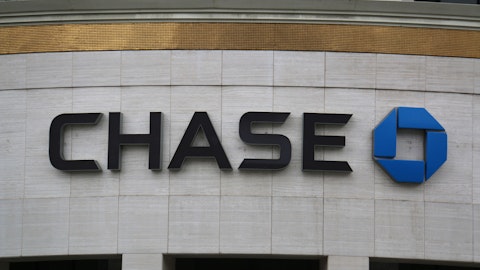The Bank of New York Mellon Corporation (NYSE:BK) Q1 2023 Earnings Call Transcript April 18, 2023
The Bank of New York Mellon Corporation reports earnings inline with expectations. Reported EPS is $1.12 EPS, expectations were $1.12.
Operator Good morning, and welcome to the 2023 First Quarter Earnings Conference Call hosted by BNY Mellon. At this time, all participants are in a listen-only mode. Later, we will conduct a question-and-answer session. Please note that this conference call and webcast will be recorded and will consist of copyrighted material. You may not record or rebroadcast these materials without BNY Mellon’s consent.I will now turn the call over to Marius Merz, BNY Mellon, Head of Investor Relations. Please go aheadMarius Merz Thank you, operator, and good morning, everyone. Welcome to our first quarter 2023 earnings call. As always, we will reference our financial highlights presentation, which can be found on the Investor Relations page of our website at bnymellon.com.I’m joined by Robin Vince, President and Chief Executive Officer; and Dermot McDonogh, our Chief Financial Officer.
Robin will start with introductory remarks and Dermot will then take you through the earnings presentation. Following their remarks, there will be a Q&A session.Before we begin, please note that our remarks include forward-looking statements and non-GAAP measures. Information about these statements and non-GAAP measures are available in the earnings press release, financial supplement and financial highlights presentation, all available on the Investor Relations page of our website. Forward-looking statements made on this call speak only as of today, April 18, 2023, and will not be updated.With that, I will turn it over to Robin.Robin Vince Thank you, Marius, and good morning, everyone. Before I turn the call over to Dermot to review our financial results, I want to provide some broader perspectives and an update on how we’re serving our clients stepping up as a [firm] (ph) in this complex environment.
Following a relatively benign start to the year, markets were quite unsettled in March, when we saw two prominent bank failures in the United States and a government brokered distressed bank takeover in Europe.While things have calmed down somewhat over the past couple of weeks, after over a decade of zero interest rate monetary policies, the risks and uncertainty associated with the fights against inflation, higher interest rates and quantitative tightening, together with geopolitical tensions remain elevated. And domestically, we continue to march closer to another debt ceiling standoff.Against this backdrop, it’s a healthy reminder that the strength of BNY Mellon’s highly liquid lower credit risk and well-capitalized balance sheet, in combination with the resilience of our platforms is the bedrock that supports our client franchise.For nearly 240 years, we’ve built up a legacy of client and industry trust rooted in our resiliency through good times and bad.
We’ve been a port in the storm for our clients in periods of stress over that time and recent weeks have been no different as we’ve helped our clients to navigate the volatility in markets with our strong balance sheet and broader liquidity solutions.After seeing deposit balances increase following recent market events, we ended the quarter slightly higher than where we started it. And our broader liquidity platform, which manages over $1.3 trillion worth of cash and other short-term investment options on behalf of our clients has seen growth across most channels.But more broadly, the recent events have led to concern around the health and stability of some banks as they’ve highlighted the critical importance of robust asset and liability management for all financial services participants as one of the largest banks in the United States and as a G-SIB we are held and we hold ourselves to a high standard, including stringent capital, liquidity and stress testing requirements.On capital, unrealized losses related to our available-for-sale investment securities portfolio are already reflected in our capital ratios.
We have consistently maintained the majority of our investments securities portfolio as available for sale. And as you will recall, we’ve had a view for a while now that rates would be a little higher in their terminal rate than the market has been pricing it. And so, over the last 1.5 years, we meaningfully reduced the duration and enhanced the risk and liquidity profile of the portfolio.Together, these actions provide us with ample flexibility to adjust to changing market conditions as we move through the year. And on liquidity, our robust liquidity management framework includes risk metrics such as concentration limits and daily liquidity stress testing protocols that go beyond regulatory requirements. It is these periods of stress that also showcase our characteristic resilience and the power of our diversified and lower-risk business model.We primarily serve large institutional clients who collectively maintain substantial deposit balances with us as part of the services we provide to support their business activities whether that’s custody, cash management, clearing and corporate trust services.
As a result, roughly 2/3 of our deposit base is operational and sticky in nature and derived from a diverse set of business lines.And as I mentioned earlier, we manage over $1 trillion of cash on behalf of our clients across deposits, money market funds, repos and securities lending, which allows us to retain a connection to the money when it moves around various short-term investment alternatives. And we’re also the largest provider of collateral services globally, our average tri-party balances increased to $5.6 trillion this quarter, which is another example of just how comprehensive our role is in the broader liquidity ecosystem.Now turning to our financial performance in the quarter. As you can see on Page 2 of our financial highlights presentation, we delivered solid results.
We reported earnings per share of $1.12, up 30% year-over-year or up 20% excluding notable items, primarily in the first quarter of last year. Revenue was up 11% year-over-year.We closely managed expenses, up 3% year-over-year, and we generated a healthy return on tangible common equity of 20%. And given how in focused capital and liquidity are at the moment, I’ll note that our Tier 1 leverage ratio as well as our liquidity coverage ratio remains strong and unchanged compared to the prior quarter, well above regulatory requirements and our own management buffers.Stepping back for a moment, I’m encouraged by the early progress that we are seeing around the Company to deliver on the commitment that we made to you back in January. First, we are bending the cost curve.
Our first quarter expense growth came in marginally better than our initial internal plan and we remain firmly committed to cutting our core expense growth by roughly half this year compared to 2022 on a constant currency basis.Second, in line with our outlook for the year, we continued to derive healthy growth in net interest revenue. Third, we delivered positive operating leverage on a year-over-year basis. And fourth, we returned a meaningful amount of capital to our shareholders, including $1.3 billion of common share repurchases.We’ve made good initial progress on our plan to return more than 100% of earnings to shareholders in 2023, and we currently expect to continue buying back stock, albeit at a slower pace given the uncertain environment.
At the same time, I’ve made a promise to you to call it as it is when we fall short of our expectations. And so to be candid, our fees being flat year-over-year was somewhat lackluster.Having said that, there were a number of business highlights this quarter that are designed to help us change this trajectory and drive underlying fee growth over time. And so I’ll call out a few. In Asset Servicing, the pipeline remains strong, and the margin on new deals is improving as we’re increasingly holding the line on price to drive more profitable growth in the business.ETF activity is up across all measures with healthy increases in AUC/A, orders and flows and wins with [Vault] (ph) and in our data platform service business were pleasing to see this quarter.
In January, we announced the launch of our outsourced trading business powered by a platform that already executes more than $1 trillion in volumes annually for our investment management business.This global multi-asset trading service can help clients to reduce their costs and focus on alpha generation. While still early days, we think there is significant opportunity here to offer front office trading capabilities in a trusted, un-conflicted way to the market.Pershing brought in a healthy $37 billion of net new assets during the quarter, representing mid-single-digit organic growth on an annualized basis and total revenue was a quarterly record. As part of BNY Mellon, clients recognize Pershing as a source of strength and stability in the marketplace.
In the current environment, clients also appreciate the flexibility and choice of our product offering.Meanwhile, our Pershing X team continues to make great progress as we aim for a broader rollout this summer. Just last week, we announced a collaboration with Snowflake to provide our prospective Pershing X clients with more powerful analytics and faster data management, improving their digital experience so they can operate more efficiently.Clearance and Collateral management activity remained elevated, given the volatility in the market and as dealers increasingly finance larger inventories via tri-party. We continue to see growth from the investments that we’ve made to increase market connectivity by expanding our tri-party platform into new markets across Asia and EMEA and into new trade types and collateral pools, reinforcing our role as the only truly global provider of collateral management.Treasury Services delivered broad-based client wins across U.S. dollar, digital and FX payments, liquidity and trade finance products and also saw a nice pickup in account and operational deposit growth towards the end of the quarter.Investment and Wealth Management, although our investment performance remains solid, AUM flows were mixed with strength in fixed income and LDI strategies partly offset by outflows in other long-term strategies.During the quarter, our U.K. investment manager Newton launched five future legacy funds, its first range of risk-rated sustainable multi-asset funds to support growth in the U.K. retirement market.

nick-pampoukidis-t-UV1rZqPuY-unsplash
And back in the U.S., the Dreyfus Bold share class, which we introduced last year, has now raised over $4 billion in AUM.In summary, over the past few months, I’ve spoken about our combination of client trust at scale platforms, client-focused culture and resilience as a powerful foundation on which we can build. I’m also proud that our culture has been front and center in recent weeks as our people have risen to the occasion, responding commercially and working tirelessly to enable successful outcomes for our clients in these uncertain times.I view this client-first culture as the key to make more out of our diversified portfolio of adjacent businesses. While we are the world’s largest custodian and a trust bank, the contributions from Clearance and Collateral Management, Pershing, Treasury Services and Issuer Services are differentiating in our client value proposition.With that, let me officially welcome Dermot to his first earnings call.
Dermot, over to you.Dermot McDonogh Thank you, Robin, for the introduction, and good morning, everyone. It’s a privilege to be here, and I look forward to working with you all. I’ll start on Page 3 of the presentation with some additional details on our consolidated financial results in the first quarter.Total revenue was $4.4 billion, up 11% year-over-year. This reflects fee revenue being flat as headwinds from lower market value, a stronger dollar and the sale of Alcentra, which closed in November last year, were offset by significant improvement in fee waivers and the absence of a notable item last year related to Russia.Firm-wide assets under custody and/or administration of $46.6 trillion increased by 2% year-over-year. Growth from new and existing clients more than offset the stiff headwinds from lower market values and currency translation, a real testament to the strength and diversification of our franchise.Quarter-over-quarter, assets under custody and/or administration increased by 5%.
Assets under management of $1.9 trillion decreased by 16% year-over-year. Here, the impact of lower market values and the stronger dollar was tempered by cumulative net inflows over the 12 months. Quarter-over-quarter, assets under management increased by 4%.Investment and other revenue was $79 million, and included another strong quarter of fixed income trading on the back of elevated volatility and greater demand for U.S. treasuries. And net interest revenue increased by 62% year-over-year, primarily reflecting higher interest rates.Expenses were up 3%, driven by higher investments and revenue-related expenses, partially offset by efficiency savings and the impact of the sale of Alcentra. The impact of inflation and merit increases were largely offset by the favorable impact of the stronger dollar.
And the provision for credit losses was $27 million in the quarter, reflecting changes in the macroeconomic forecast.As Robin mentioned earlier, earnings per share were $1.12, up 30% year-over-year or up 20% excluding notable items, largely in the first quarter of last year. Our reported pre-tax margin was 28% and our return on tangible common equity was 20%, the highest in three years.Turning to capital and liquidity on Page 4. Our Tier 1 leverage ratio, which continues to be our binding capital constraint, was 5.8%, essentially flat quarter-over-quarter, and our CET1 ratio was 11%. The strength of our balance sheet and our healthy earnings generation in the quarter allowed us to return $1.6 billion of capital to our common shareholders, including $1.3 billion of common share repurchases while maintaining our capital ratios well above regulatory minimum and above our more stringent management target.Similarly, on liquidity coverage ratio was 118% and also unchanged compared with the prior quarter.
The strength of our highly liquid, lower credit risk and well-capitalized balance sheet is one of the cornerstones of our franchise. Starting in late ’21 and throughout ’22, we proactively reduced the duration and enhanced the risk and liquidity profile of our investment securities portfolio, while consistently keeping over 60% of the book available for sale to position ourselves with at flexibility for changing market and interest rate conditions.Between the beginning of this year and early March, we saw deposit balances declined in line with typical seasonal patterns and in line with our expectations, considering continued Central Bank tightening via both rate hikes and quantitative tightening. This was followed by a swift increase in deposit balances as clients of the strength of our balance sheet during the recent turmoil in the banking sector.
We ended the quarter with deposit balances up 1% sequentially on a period-end basis, but we expect continued moderation of deposit levels in the months ahead.Now moving on to net interest revenue and further details on the underlying balance sheet trends on Page 5, which I will describe in sequential terms. Net interest revenue of $1.1 billion was up 7% quarter-over-quarter. This sequential increase reflects higher yields on interest-earning assets, partially offset by higher funding costs and the impact of balance sheet size and mix. Our just clearly a very volatile quarter in rates markets, it is worth noting that, on average, realized rates were in line with our projections for the quarter. Our outperformance compared to our prior expectations was primarily driven by slightly lower-than-expected deposit basis.On a quarterly average basis, deposit balances decreased by 3% sequentially.
Noninterest-bearing deposits represented 26% of total deposit balances, which continues to be above our long-term range of 20% to 25% based on historical averages in normal interest rate environment. Average interest-earning assets decreased by 1% quarter-over-quarter. Underneath that, cash and reverse repo was flat, loan balances were down 6%, and our investment securities portfolio was flat.Moving on to expenses on Page 6. Expenses for the quarter were $3.1 billion, up 3% year-over-year. As mentioned earlier, this reflects investments in higher revenue-related expenses, partially offset by efficiency savings and the impact of the sale of Alcentra. The impact of inflation and merit increases was largely offset by the favorable impact of the stronger dollar.Robin has been clear about our determination to bend the cost curve.
We’re executing with discipline and urgency, as you can see signs of our delivery in our professional, legal and other purchase services, net occupancy and business development line. We feel good about our progress in the first quarter and how it positions us for efficiency savings in the coming quarters to help us meet our goals for the year.Turning to our business segments. Let’s start with Security Services on Page 7. As I discussed the performance of our Securities Services and Market & Wealth Services segment, I will comment on the investment services fees for each line of business described in our earnings press release and the financial supplement.Security Services reported total revenue of $2.1 billion, up 19% year-over-year. Fee revenue was up 4%.
Within this FX revenue was down 6% as the benefit of higher volatility was more than offset by a decline in emerging market volume and net interest revenue was up 77%. In Asset Servicing, investment services fees decreased by fee waivers and net new business was more than offset by the impact of lower market values, lower client activity and the stronger dollar.In Issuer Services, investment services fees increased by 67%. This increase largely reflects the absence of the notable item last year related to Russia as well as lower money market fee waivers in Corporate Trust.Next, Market and Wealth Services on Page 8. Markets & Wealth Services reported total revenue of $1.5 billion, up 22% year-over-year. Fee revenue was up 10% and net interest revenue increased by 53%.In Pershing, investment services fees were up 15%, primarily driven by the abatement of money market fee waivers, partially offset by lower client activity.
Net new assets were a healthy $37 billion in the quarter, and average active clearing accounts were up 6% year-on-year.In Treasury Services, Investment Services fees decreased slightly by 1% driven by higher earnings credit on noninterest-bearing deposit balances on the back of higher interest rates, partially offset by lower money market fee waivers and net new business. And in Clearance and Collateral Management, Investment Services fees were up 7%, largely reflecting higher used government clearance volumes and make continued demand for U.S. treasuries.Moving on to Investment and Wealth Management on Page 9. Investment and Wealth Management reported total revenue of $827 million, down 14% year-over-year. Fee revenue was down 15%. Investment and other revenue was $6 million in the quarter primarily reflecting free capital gains as opposed to losses in the first quarter of last year, and net interest revenue was down 21% year-over-year.
Assets under management of $1.9 trillion decreased by 16% year-over-year.As I mentioned earlier, this decrease largely reflects lower the unfavorable impact of the stronger dollar, partially offset by cumulative net inflows. In the quarter, we saw $5 billion of net inflows into long-term products. We continue to see healthy net inflows into our LDI strategies of $10 billion, and we also saw $4 billion of net inflows into our fixed income strategy.In cash, where we expected outflows from a small number of clients, this was offset by healthy inflows on the back of our continued strong investment performance.In Investment Management, revenue was down 15% year-over-year. This decrease reflects the impact of the sale of Alcentra, the mix of cumulative net inflows, lower market values and the stronger dollar and was partially offset by lower money market fee waivers.In Wealth Management, revenue was down 12%, driven by lower market values and changes in product mix.
Client assets of $279 million was down 9% year-over-year, primarily driven by lower market values. Page 10 shows the results of the other segments.I’ll close with a few comments on how we’re currently thinking about our financial outlook for the year, which in short remains basically unchanged. From our earnings call in January, you will recall that based on March implied forward interest rates at the end of last year, we projected an approximately 20% year-over-year increase in net interest revenue for the full year ’23.As you all know, we continue to see significant volatility in rates, markets and market implied forward interest rates currently suggest some meaningful fed easing relative to the dock plots. We have positioned ourselves for continued interest rate volatility and retain ample flexibility and liquidity to respond to a wide range of outcomes as the ultimate impact of continued tightening remains uncertain.We’re off to a good start in the first quarter.
And based on March implied forward interest rates at the end of March, we still believe our outlook for 20% year-over-year growth in net interest revenue is realistic with some skew to the upside.We also still expect expenses, excluding notable items to be up 4% year-over-year, assuming foreign exchange rates at the end of last year or by approximately 4.5% on a constant currency basis. As we said on our earnings call in January, we are determined to deliver some positive operating leverage this year.We still expect an effective tax rate in the 21% to 22% range and finally, as we calibrate the amount and pace of our continuing share repurchases in the weeks and months ahead, we will be mindful of the continued uncertainty in the operating environment, especially as it relates to the uncertain path of interest rates and so we’re planning to maintain our current more conservative capital buffers for the time being.So to wrap up, we’re pleased with the Company’s solid financial performance in the first quarter which have made a challenging operating environment once again showcased the strength and resilience of our business model.
As we look forward, we are continuing to manage our balance sheet conservatively and we are confident that we are well positioned to help our clients navigate the elevated uncertainty in global markets.With that, operator, can you please open the line for Q&A.
See also 35 Most Beautiful Places In The World and 8 Best Insider Trading Websites in 2023.
Question-and-Answer Session Operator [Operator Instructions]
Our first question comes from the line of Ken Usdin with Jefferies.Ken Usdin Welcome, Dermot. To follow up on your NII, you reiterated 20%, perhaps a little upside. Obviously, with a good start to the year that implies a sequential slide as the year goes through. Can you just kind of help us understand how that works through in terms of what you’re expecting for deposit trends and liability costs as you look through to that.Dermot McDonogh Okay.
Good morning, Ken. And thanks for the question. Before I answer, I’d just like to acknowledge Emily, who is the former CFO and has been a tremendous partner with the transition and to the finance team and Investor Relations team who really helped me settle in well, and it’s a real privilege to be here, and I look forward to working with you all.So on to your specific question around the mix between NII and deposits. Look, back in January, the environment was a little bit different to where it is today. We feel we’ve had a very good start to NII. We did a lot of scenario analysis in January to come up with that number. And look, there was a big kind of divergence between the market implied forward curve, which we use to kind of budget and project where we think NII is versus where the Fed is in the dot plots.
If you look at it today, there’s a little bit more of a coming together of that and there’s more of a market color around higher for longer.We’re positioned for that. We feel good about this. And as a consequence of that, we’ve locked in a good quarter and we feel good about subsequent quarters. And look, the important thing in my remarks was skewed to the upside. The range of outcomes is probably more uncertain today than it was in January. We have the debt ceiling to come, geopolitical uncertainty, all the factors that you would know about. And as a consequence, I don’t really want to update the guidance, but feel we’re solid on 20% with that skewed to the upside.Ken Usdin Got it. Great. And just as a follow-up then, can you maybe just flesh out a little bit how you’re thinking about how the deposit trends go from here, both in an absolute sense?
And then perhaps what that mix of DDAs to total looks like from, I think, the 26% that you posted this quarter?Dermot McDonogh Sure. So, if you kind of take a step back on deposits and think about coming out of the pandemic and as people started to focus on inflation and having better yield opportunities and you look at the system in total, you see over the course of the last 15 months across the industry, deposits leaving the system, we’re kind of tracking that. And we’re the same really as everybody else. We’re down 3% in terms of average deposits and maybe if I kind of double-click on what happened in the quarter, a little bit, up to March, we were in line with our forecast, which kind of gave us the 20% year-over-year growth.We kind of had a blip to the upside for deposits in the latter part of March as a result of a little bit of the turmoil that happens there.
We saw a flight to our balance sheet. People wanted to use our platform. And so we saw deposits elevate. Now that’s largely moderated, albeit we’re a little bit above our forecast, we expect that to moderate further like the rest of the industry in the coming quarters as our clients are sophisticated and they will look for yield.But look, I refer you to Robin’s comments in his remarks where he talked about the cash ecosystem and we kind of touched $1.3 trillion of a cash ecosystem, we want to point them to our products and services. So while they may not use our deposit platform, we want them to use other products within our ecosystem. So, we feel very good about where our deposit balances are and the trajectory for the rest of the year.Operator And our next question will come from Steven Chubak with Wolfe Research.Steven Chubak So, I wanted to start off with just a question on some of the buyback commentary.
We saw a strong capital return in the quarter. You noted plans to temper the pace of buyback, was hoping to get some more context as to what’s informing that decision. If I think about some of the key inputs, the leverage denominator should be shrinking, albeit modestly, given some of the deposit commentary you decided, you’ve sounded more sanguine on Basel IV, you’re less exposed to credit shocks. It just feels like you’re better placed than most to continue a healthy pace of buyback. Just want to understand the decision to retrench a bit in terms of the pace of deployment.Robin Vince Thanks for the question, Steven. I wouldn’t use the word retrench. I would just go back to January and kind of just reaffirm what we said we’d do, which is return north of 100% of earnings to our shareholders this year.In Q1, it was a total of $1.6 billion, of which $300 million was dividends, $1.3 billion in share repurchases.
So a good start, March came along, and maybe some of it is me being a freshman CFO and wanting to just slow down the pace a bit to see how the macro environment plays out. There’s a lot of uncertainty out there.I would reiterate, we are going to continue to buy back but we’re just going to take it easy now and watch the situation day by day, week by week. If the situation clarifies itself. If we get debt ceiling resolution, there are a lot of things that play into the next couple of months, and we’ll watch and see and adjust accordingly.Steven Chubak So just to understand, is it’s — you’re making adjustments, but are you still committed to the 100% payout or north of 100% payout at least for the time being?Dermot McDonogh That’s correct, Steven.Steven Chubak Okay, great.
And just for my follow-up on the topic of efficiency, really encouraging to hear that you’re doubling the efficiency savings this year. I know you had highlighted that previously. We saw some really nice progress in improving the Security Services operating margin. You talked about staying disciplined on managing cost there. With the margin there above 25%, how quickly do you think you can get to that 30% margin? I wanted to understand what your plans are for the Investment Management segment, in particular. The pro forma the Alcentra sale, the margin there is fairly subdued, just wanted to get some expectation around where you think that margin could potentially traject to over time, what your plans are in terms of efficiency, if there are any for the investment management segment as well?Dermot McDonogh Okay.
So, there were a few questions there. So I’ll try and deal with them as best I can. So, if we kind of zoom out for a second and look at the firm, yes, a 28% margin with a 20% ROTCE, the highest in three years, okay? So margin good, always want to improve. And then you double click into that and you go Security Services, 26% going to 30%.The positive in there is Emily was the CFO for a number of years, and now I get to partner with her figuring out how to drive that margin higher. And so we have a plan, you will have noted that we committed to half the expense growth year-over-year. We’re off to a good start and that will have — that will — that segment will be a beneficiary of that.Then you double click into the next segment, which is Market & Wealth Services, which is a 48% margin, which I have no problems as CFO with that long may it continue.
And then we go into Investment and Wealth Management, which 11% margin is a bit — to be honest, it’s probably a bit disappointing. But 18 months ago, that was a 30% margin business. And we don’t see any reason why we can’t get back there with a lot of hard work.There were quite a number of headwinds going into that last year, lower market values, a significant strengthening of the dollar. And some of our clients wanted to do a bit of a mix shift from equities to fixed income, and that was going from higher fee to lower fee, but the important point that I would draw to you there is the clients stayed in our ecosystem and that’s the key message. Clients are in our ecosystem and just mix shifting, and we’re working with our clients to deliver good outcomes for them.Operator And our next question will come from Alex Blostein with Goldman Sachs.Alex Blostein I was hoping we can zone in on fees in Investment Services, particularly within Asset Servicing and Pershing.
At a macro level, it feels like a lot of things have gone your way, markets were up. Activity rates were very strong, particularly in treasuries, money market funds, retail, et cetera. So all sort of things in your wheelhouse, yet the revenues in both businesses were down sequentially. So you just unpack a little bit what were some of the offsets that drove to disappointment on fees? And as you look out, I guess, for the rest of the year, I think on the Q4 call, you guys made comments around just the overall firm-wide fee growth for 2023. Just wondering to get your latest thoughts on that?Dermot McDonogh Alex, hope you’re well. As a former colleague, I think you were supposed to ask me an easy question, not a hard question. So look, Asset Servicing, the way I kind of think about Asset Servicing is — and look, the headline number is 2% down, yes.
That equates to a little over $50 million, yes. In the context of our quarter, that’s a small number. So the way I kind of think big picture, again, I’ve said this in the answer to other questions, did we attract clients to our ecosystem, yes.And then within that, is like how do we derive fee revenue from those clients. Some of it is to do with market levels, some of it has to do with volume and some of it is other stuff like account opening. So within that context, we did see a risk-off sentiment from our clients wanting to pause, push stuff out to subsequent quarters. So the client volumes were down, and so that really kind of drove the Asset Servicing side of it.And if you kind of look at Issuer Services, it’s a smaller number for us, but that’s a seasonal business, and depository receipt is within that.
And Q1 is typically a quiet quarter there, and we’ll expect that to pick up in Q2 for dividend season. And on the plus side for Asset Servicing, we had higher market levels, and we got some fees from that. So overall, I feel good about Asset Servicing. We have to work hard on the fee outlook, but it’s not — I would say, it’s not as negative as some commentators would portray the fee outlook to be as I see the situation today.As it goes to Pershing, look, we’re very excited about the Pershing business. You’ll see from our commentary in our prepared remarks that we had $37 billion onto our system. Robin talked about it in his prepared remarks we’re very excited about Pershing X. The partnership with Snowflake, we’re going to do a lot of great stuff in that area, and we will tell you about it as the quarters unfold, but Pershing and Pershing X is very, very exciting for us.Alex Blostein Got you.





